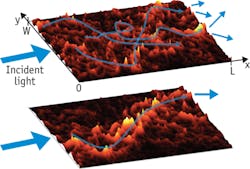BIOMEDICAL IMAGING: Optical absorption's suppression of interference promising for biomedical imaging
A new discovery could improve medical imaging within biological tissue: Physicists from the University of Twente (Enschede, The Netherlands) and Yale University (New Haven, CT) found that light traveling through a diffusing material follows a straighter path if the material partially absorbs the light.1
Photons traveling through a scattering medium perform a random walk, which resembles an uncoordinated stagger. The researchers found that in opaque media such as biological tissue, light absorption actually straightens this path, leading to less diffraction by scattering and thus improved imaging through the material.
This seems counterintuitive: Light absorption is usually detrimental for imaging, as it reduces the intensity of the visible image. But the researchers discovered that if enough light is absorbed, interference is suppressed; numerical calculations showed that long, meandering light paths are suppressed far more than short, straight paths. With increasing absorption, straight ("ballistic") light paths persist while the number of scattered paths is considerably reduced.
1. S. F. Liew et al., Phys. Rev. B, 89, 25 (2014); doi:10.1103/PhysRevB.89.224202.
